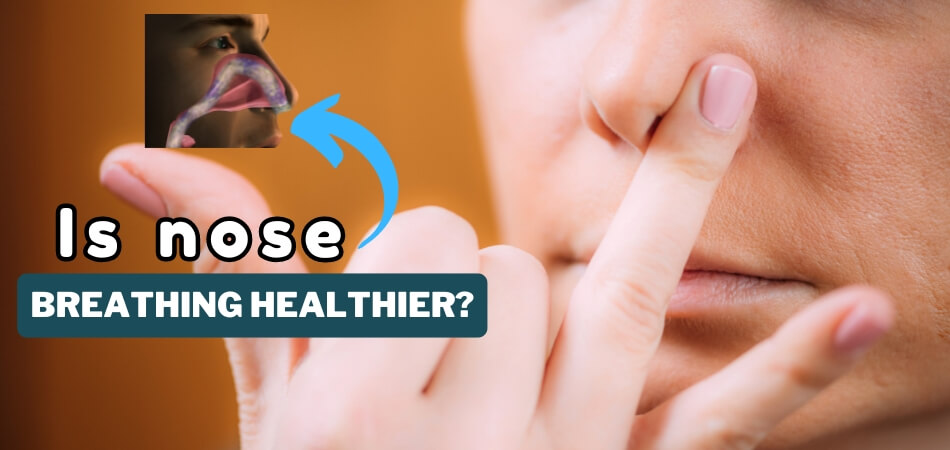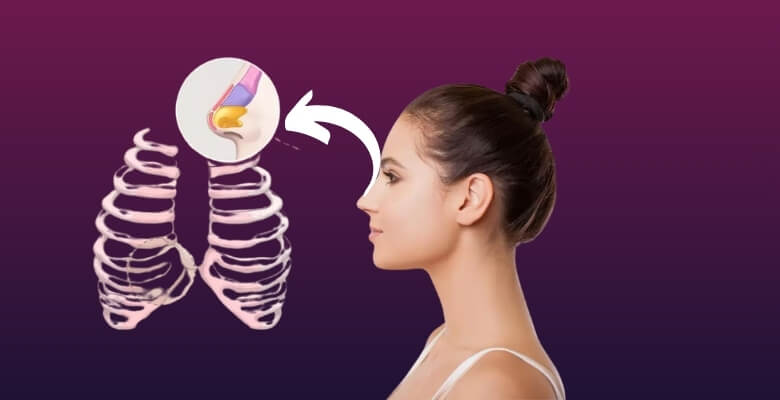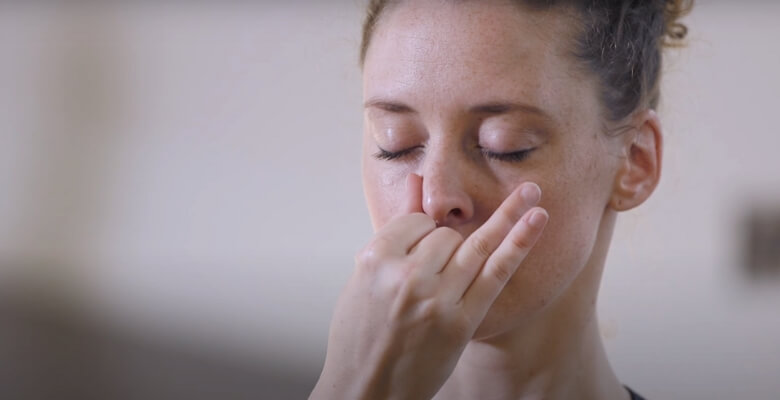A new practice is gaining attention in the world of wellness trends and health hacks: Hale Breathing. If you’ve heard of Hale Breathing, it’s the art of consciously breathing through your nose. Despite the noise of modern life, does this age-old technique still work? Is nose breathing healthier?
Yes, nose breathing is generally healthier. It helps filter, humidify, and warm the air, reducing the risk of respiratory infections and promoting better lung function. Additionally, nasal breathing promotes relaxation and activates the diaphragm, enhancing oxygen uptake and CO2 exchange.
Let’s explore the fascinating world of nose breathing and discover how it can transform our health.
What is Noise Breathing?
Noise Breathing is a term associated with the sensation of restricted airflow through the nasal passages during breathing. It’s often accompanied by audible sounds like whistling or snoring due to air turbulence.

One solution to alleviate noise breathing is the Hale Breathing device. This FDA-registered device is incredible, unique, and flexible, designed to open the nasal passage and help users breathe more easily. By gently holding the nose open, it promotes smoother airflow and reduces the noise associated with breathing.
Noise Breathing, using devices like Hale Breathing, is a non-intrusive solution for nasal congestion and snoring. The user and their bed partner have more peaceful sleep when the nasal passages are gently opened, reducing airway resistance.
Is Nose Breathing Healthier?
Yes, nose breathing is generally healthier. Breathing through the nose filters, warms, and humidifies the air, which helps protect the lungs and respiratory system from harmful particles and pathogens. Use the Hale Breathing device for easy breathing. You should know about the working system of hale breathing.
It also promotes better oxygen absorption and maintains proper carbon dioxide levels in the body.

Nasal Filtration
Breathing through the nose allows air to pass through the nasal hairs, which act as a filter, trapping dust, pollen, and other particles. This helps prevent these irritants from reaching the lungs, reducing the risk of respiratory infections and allergies.
Air Temperature Regulation
The nasal passages are lined with blood vessels that warm the air as it enters the body, ensuring it reaches the lungs at an optimal temperature. This helps prevent irritation and discomfort in the respiratory tract, especially during cold weather or exercise.
Humidification
The nasal cavity produces mucus, which adds moisture to the air we breathe, preventing the respiratory tract from becoming too dry. This moisture helps soothe the airways, reducing the risk of irritation, coughing, and inflammation.
Nitric Oxide Production
Nose breathing stimulates the production of nitric oxide, a gas with various health benefits, including widening blood vessels, increasing oxygen uptake in the lungs, and combating bacteria and viruses in the respiratory tract. This helps promote overall respiratory health and immune function.
What’s the Science Behind Nose Breathing?
The habit of nose breathing has its roots in biology and physiology. Our health and well-being can be improved by understanding the science behind it.

Nasal Anatomy and Function
The nose is more than a protruding facial feature; it’s a complex organ with crucial functions. Its structure includes the nasal cavity, turbinates, and mucous membranes, all vital for filtering, humidifying, and warming incoming air.
Role in Air Filtration
The nasal passages act as a natural air filter, trapping harmful particles and pathogens. This filtration process helps prevent irritants and pollutants from reaching the lungs, reducing the risk of respiratory issues and infections.
Humidification and Moistening
As air travels through the nasal cavity, it encounters moist mucous membranes. These tissues add moisture to the air, preventing the drying out of delicate lung tissues and ensuring optimal conditions for gas exchange.
Temperature Regulation
The nasal cavity also plays a role in regulating the temperature of incoming air. By passing through the narrow nasal passages, the air has more contact with the warm tissues, allowing it to reach body temperature before entering the lungs.
Nitric Oxide Production
Nose breathing stimulates the production of nitric oxide (NO) in the nasal sinuses. NO is a potent vasodilator that helps widen blood vessels, improving blood flow and oxygen delivery throughout the body.
Enhanced Oxygen Uptake
Compared to mouth breathing, nose breathing promotes more efficient oxygen uptake. The nasal turbinates create resistance, allowing the body more time to extract oxygen from the air before it reaches the lungs.
Support for Respiratory Health
Consistent nose breathing is linked to better respiratory health and reduced risk of conditions like asthma and bronchitis. It promotes proper lung function and strengthens the body’s natural defenses against respiratory infections.
What are the Benefits of Breathing Through Your Nose?
It’s important to choose the right way to breathe, whether you breathe through your nose or mouth. Here’s why you should breathe through your nose:
- Noise breathing filters out impurities like dust, pollen, and bacteria, reducing the likelihood of respiratory infections and allergies. The tiny hairs in your nose, called cilia, trap these particles, preventing them from entering your lungs.
- It regulates the temperature and humidity of the air you inhale, ensuring it’s at an optimal level for your respiratory system. This helps prevent irritation and dryness in your airways, reducing the risk of conditions like asthma and bronchitis.
- Breathing through your nose boosts the production of nitric oxide, a molecule that dilates blood vessels and improves oxygen absorption in your lungs. This enhances your overall respiratory efficiency and supports better cardiovascular health.
- Nasal breathing activates the lower lobes of your lungs, where a higher concentration of blood vessels exists, promoting better oxygen exchange. This improves your body’s oxygenation and energy levels, enhancing athletic performance and endurance during physical activities.
- It stimulates the production of saliva, which contains enzymes that aid in digestion and protect your teeth from decay. Proper digestion begins in the mouth, and nasal breathing supports this process by ensuring adequate saliva production.
- Nasal breathing encourages proper alignment of the jaw and teeth, preventing issues like malocclusion and temporomandibular joint (TMJ) disorders. This reduces the risk of dental problems and facial pain associated with mouth breathing.
- It activates the parasympathetic nervous system, promoting relaxation and reducing stress levels. This can lead to improved sleep quality, as nasal breathing helps calm the mind and prepare the body for restful sleep.
- Nasal breathing encourages diaphragmatic breathing, where the diaphragm contracts and moves downward, allowing the lungs to fully expand. This deep breathing technique increases oxygen intake and promotes relaxation, reducing tension in the body.
- It enhances the production of nitric oxide, which has antimicrobial properties that help defend against pathogens like viruses and bacteria. Nasal breathing supports your body’s natural defense mechanisms, boosting immunity and reducing the risk of respiratory infections.
Practical Tips for Improving Nose Breathing
Improving nose breathing can enhance overall well-being and boost oxygen intake. Proper nasal breathing can alleviate snoring, enhance sleep quality, and even reduce stress levels. Here are some practical tips to help you breathe better through your nose:

Practice Nasal Breathing Exercises
Engage in simple exercises like alternate nostril breathing to improve airflow and strengthen nasal passages. Begin by sitting comfortably and closing one nostril with your thumb, inhaling deeply through the open nostril. Then, switch nostrils and exhale through the opposite side. Repeat for several minutes daily.
Maintain Nasal Hygiene
Keep your nasal passages clean and moist by using a saline spray or nasal irrigation. This helps remove irritants and prevents congestion, allowing for easier breathing through the nose. Regularly clean your nasal passages with a saline solution to promote clear airflow and reduce inflammation.
Address Allergies and Sinus Issues
If allergies or sinus problems hinder nose breathing, consult a healthcare professional for appropriate treatment. Allergy medications, nasal corticosteroids, or allergy shots may alleviate symptoms and improve nasal airflow. Identify triggers and take steps to minimize exposure to allergens like pollen, dust, or pet dander.
Optimize Sleeping Environment
Create an optimal sleeping environment conducive to nasal breathing. Use a humidifier to maintain moisture levels in the air, preventing dryness that can cause nasal congestion. Elevate your head slightly with pillows to promote better airflow through the nose and reduce snoring during sleep.
Practice Mindfulness and Relaxation Techniques
Incorporate mindfulness and relaxation practices into your daily routine to reduce stress and promote nasal breathing. Stress and anxiety can contribute to shallow breathing through the mouth, so techniques like meditation, yoga, or deep breathing exercises can help cultivate nasal breathing habits.
FAQs for Is Nose Breathing Healthier?
Check out these frequently asked questions and their answers to learn more about nose breathing.
Why Is Nose Breathing Considered Healthier?
Nose breathing is healthier because it filters, warms, and humidifies the air, protecting the respiratory system from harmful particles and pathogens. It also promotes better oxygen absorption and lung function.
How Does Nose Breathing Compare to Mouth Breathing in Terms of Health Benefits?
Nose breathing surpasses mouth breathing in health benefits due to its ability to filter and regulate air temperature and humidity. It also stimulates nitric oxide production, supporting respiratory and cardiovascular health.
Can Nose Breathing Help with Allergies and Respiratory Infections?
Yes, nose breathing can help alleviate allergies and reduce the risk of respiratory infections by filtering out allergens and pathogens. The nasal hairs and mucous membranes act as a natural barrier against irritants.
Does Nose Breathing Contribute to Better Sleep Quality?
Absolutely. Nose breathing promotes relaxation and activates the parasympathetic nervous system, leading to improved sleep quality. It reduces the likelihood of snoring and supports optimal oxygenation during sleep.
How Does Nose Breathing Affect Physical Performance and Endurance?
Nose breathing enhances physical performance and endurance by optimizing oxygen uptake and promoting efficient energy production. It activates the lower lobes of the lungs, maximizing oxygen exchange during activities.
Can Nasal Breathing Alleviate Stress and Promote Relaxation?
Yes, nasal breathing activates the parasympathetic nervous system, inducing relaxation and reducing stress levels. It encourages diaphragmatic breathing, promoting deeper breaths and a sense of calmness.
Final Thought
We can all benefit from nose breathing for our overall health and well-being. The science behind nose breathing is compelling. It filters out impurities and regulates air temperature to enhance oxygen uptake and promote relaxation.
Is nose breathing healthier? Yes, definitely. It’s not just a habit; it’s a fundamental aspect of our biology, rooted in the intricate functions of the nasal passages. To improve respiratory health, sleep quality, and immunity, it’s crucial to prioritize nasal breathing.
Maintaining nasal hygiene, practicing nasal breathing exercises, and addressing underlying sinus issues can all make a big difference. So let’s breathe easier and live healthier lives by embracing nose breathing.






